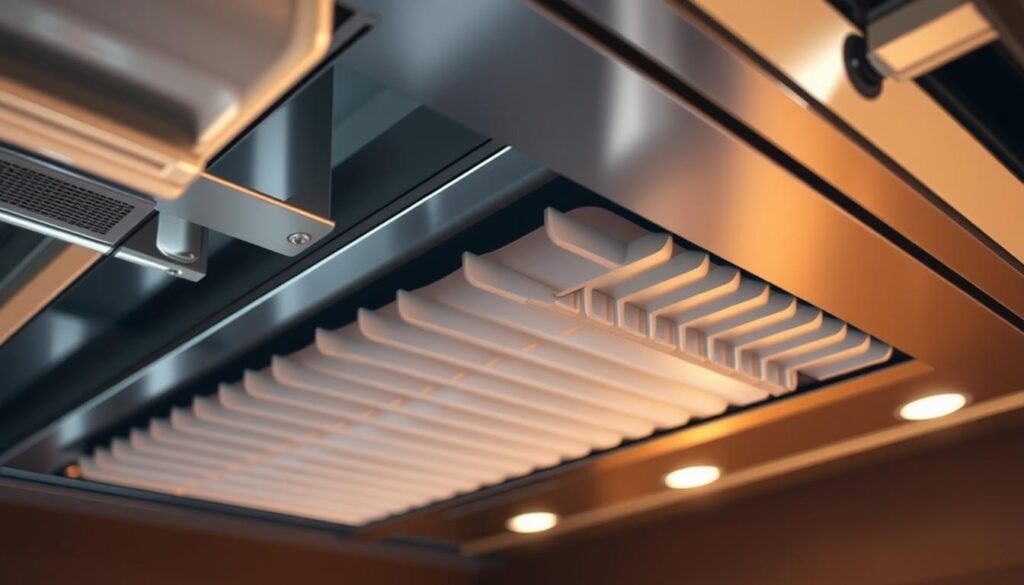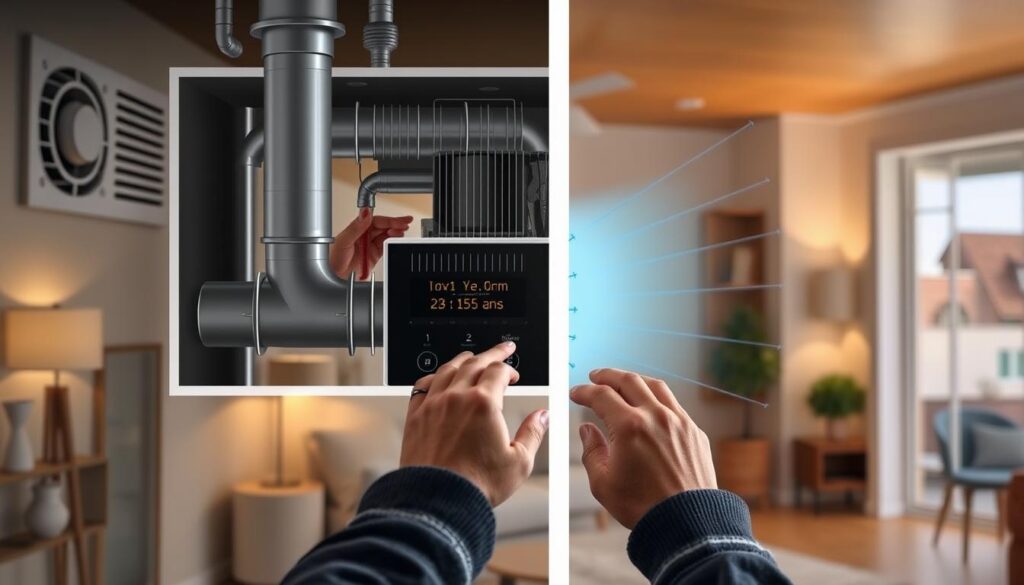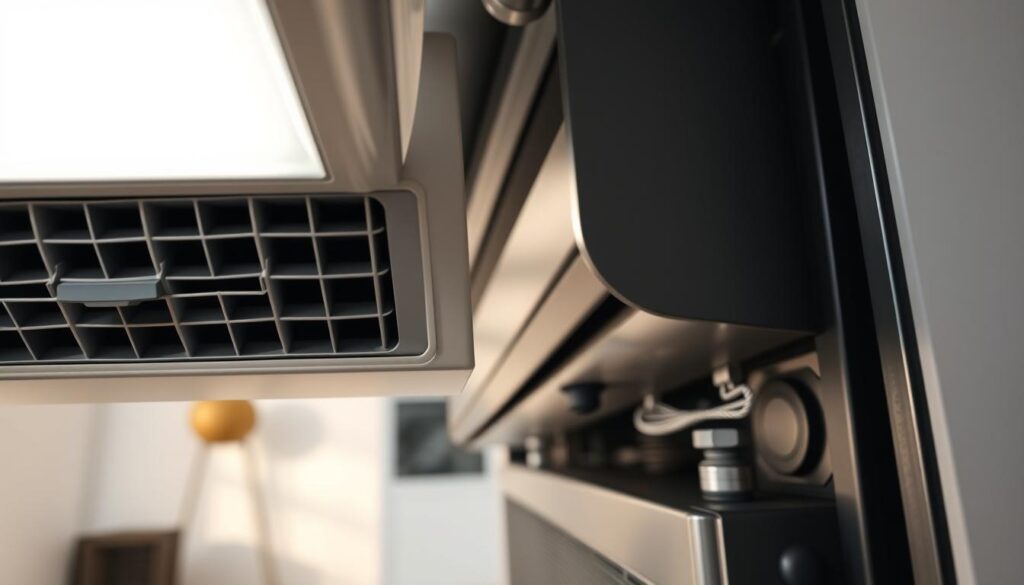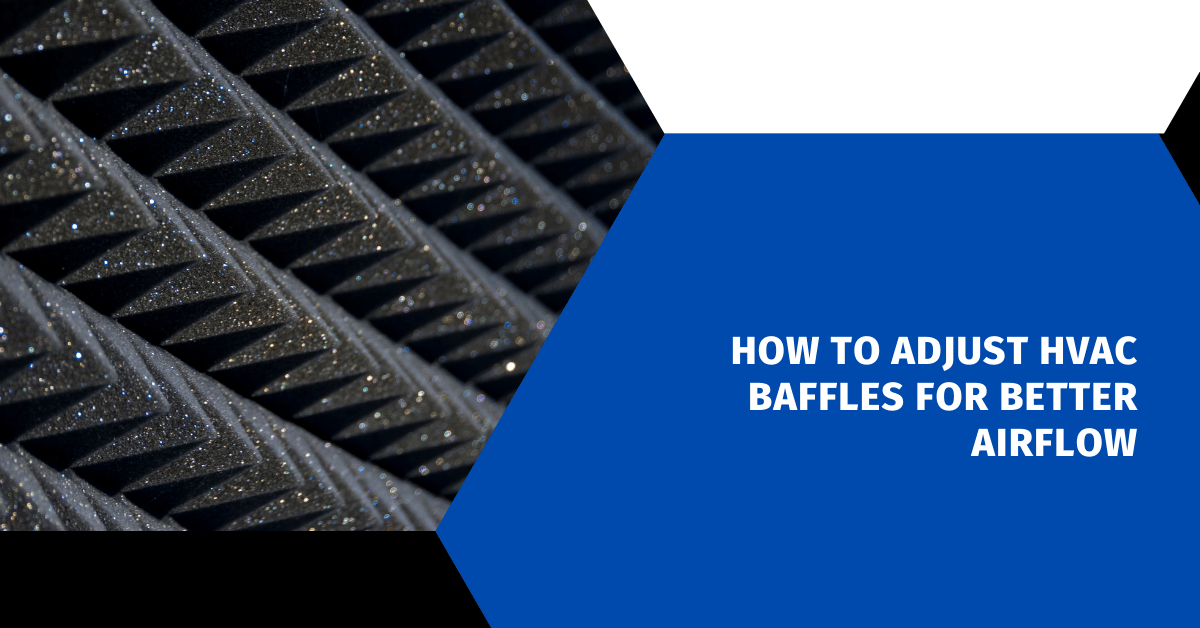Affiliate Disclosure
HVAC Guide Guys is a participant in the Amazon Services LLC Associates Program, an affiliate advertising program designed to provide a means for sites to earn advertising fees by advertising and linking to Amazon.
How to Adjust HVAC Baffles for Better Airflow? Are you tired of uneven temperatures in your home? You can learn to control hvac dampers for perfect comfort in every room.

HVAC baffles are small but powerful in your air duct system. They help direct airflow where you need it. This changes how you feel the temperature in your home.
Adjusting hvac baffles is more than just comfort. It’s about saving energy and cutting down on utility bills. By knowing how to use these parts, you can make your home’s temperature just right, saving money and energy.
Key Takeaways
- HVAC baffles control airflow in different home zones
- Proper adjustment can improve temperature consistency
- Simple modifications can enhance energy efficiency
- Damper control helps manage hot and cold spots
- Understanding your system leads to better home comfort
Table of Contents
Understanding HVAC Baffles and Their Purpose
Your home’s heating and cooling system has many parts to keep it comfy. HVAC baffles and dampers are key to balancing airflow. They help control the climate and make your home comfortable.
These smart tools manage air flow without you noticing. They help you create the ideal indoor climate. Knowing how they work lets you control your home’s temperature zones better.
What are HVAC Dampers and Baffles?
HVAC dampers are like valves in your ducts. They control air flow to different parts of your home. They direct heated or cooled air where you want it, making your system more efficient.
- Control air distribution in different rooms
- Regulate temperature in specific zones
- Improve overall HVAC system performance
How Baffles Control Airflow in Your Home
Dampers let you customize your home’s climate. They block or allow air flow to certain areas. This helps get rid of hot and cold spots, making your home more comfortable.
| Damper Type | Primary Function | Best Used For |
|---|---|---|
| Butterfly Flat Dish | Precise Air Regulation | Small Duct Systems |
| Blade Dampers | Volume Control | Large Commercial Spaces |
| Inlet Vane Dampers | Airflow Modulation | Complex HVAC Configurations |
Types of HVAC Damper Systems
There are different damper systems for home comfort. Manual dampers need you to adjust them. Automatic dampers can be controlled by electronics, making temperature control easy.
Understanding these systems helps you choose the best for your home. This way, you can balance airflow and create the perfect indoor climate.
Explore Our HVAC Shop
Looking for top-rated HVAC tools, parts, and accessories? Visit our shop and find the perfect solution for your needs.
Visit the ShopLocating Your Home’s HVAC Dampers
It’s important to know where your HVAC dampers are and what they do. They help control the air flow in your home’s heating and cooling system. This is key for adjusting ductwork and managing zones.
HVAC dampers are placed to control temperature and air flow in your home. Finding them can greatly improve your comfort and save energy.
Common Damper Locations
HVAC dampers are usually found in certain spots in your home’s ductwork:
- Near the main trunk line close to the furnace or air conditioning unit
- At major junction points in the ductwork
- In branch lines leading to different rooms or zones
- Inside the basement or attic ductwork
Identifying Different Damper Types
Dampers vary in design to support zone control. Here’s a quick guide to help you spot them:
| Damper Type | Characteristics | Location Typical |
|---|---|---|
| Manual Dampers | Lever or handle for direct adjustment | Main ductwork branches |
| Motorized Dampers | Electrically controlled, connected to thermostat | Zoned HVAC systems |
| Automatic Dampers | Self-adjusting based on temperature | Advanced climate control systems |
Signs Your Home Has Adjustable Dampers
Look for these signs that your home has adjustable dampers:
- Visible levers or handles on ductwork
- Multiple temperature zones with independent control
- Newer HVAC systems with zoning capabilities
- Separate thermostats for different home areas
Pro tip: If you’re unsure about your damper locations, consult your HVAC system’s manual or contact a professional technician for a detailed inspection.
How to Adjust HVAC Baffles for Optimal Performance
Getting the right home heating balance is key. It starts with adjusting your central air dampers. This might seem hard, but it can make your home more comfortable and save energy.
First, learn how to adjust dampers. They control air flow in your home’s zones. This lets you set the temperature and comfort in each area.
- Find the damper controls in your ductwork or near vents
- Know the fully open and fully closed positions
- Adjust in small steps
- Check temperature changes after each tweak
Here are some tips for the best results:
- Seasonal Adjustments: Summer and winter need different damper settings
- Close dampers in unused areas
- Open them in busy spots
- Keep air flow balanced for even temperatures
Adjusting for home heating balance is an ongoing task. Regular checks and small tweaks keep your home cozy. They also help your HVAC system work better.
Seasonal Adjustment Guidelines for Better Comfort
To keep your home comfortable all year, adjust your air registers wisely. It’s key to understand how seasons affect your HVAC system’s airflow and temperature.

Fixing uneven cooling starts with adjusting your HVAC baffles for each season. Every season brings its own challenges for keeping your home at a steady temperature.
Summer Adjustment Strategy
In summer, heat goes up, making upper floors warmer. To fight this, follow these steps:
- Open upper-level dampers fully to let cool air flow
- Partially close basement dampers to send cool air upstairs
- Make sure air registers are clean and free from blockages
Winter Adjustment Tips
Winter needs a different plan to stay cozy:
- Close upper-level dampers to save heat
- Open basement dampers to spread warm air
- Check air registers for dust and blockages
Transition Season Recommendations
Spring and fall need flexible air register adjustments for changing temperatures:
| Season | Damper Position | Recommended Action |
|---|---|---|
| Spring | Partially Open | Balanced airflow between levels |
| Fall | Gradual Adjustment | Slow transition of damper settings |
Pro tip: Regular maintenance and damper adjustments can greatly boost your home’s comfort and energy use.
Explore Our HVAC Shop
Looking for top-rated HVAC tools, parts, and accessories? Visit our shop and find the perfect solution for your needs.
Visit the ShopTools and Techniques for Baffle Adjustment
Adjusting HVAC baffles needs the right tools and knowledge. Your home’s hvac damper control system can be fine-tuned with precision. Some dampers have special features that make adjustments easier.
Here are the essential tools for adjusting hvac baffles:
- Flathead screwdriver
- Needle-nose pliers
- Flashlight
- Protective gloves
- Measuring tape
Modern dampers often have features that make adjusting simpler. Some have a pointed metal pin for turning and positioning. This lets homeowners make accurate changes without needing to be tech-savvy.
| Tool | Purpose | Difficulty Level |
|---|---|---|
| Screwdriver | Loosen/tighten damper connections | Easy |
| Pliers | Grip and rotate stubborn dampers | Moderate |
| Flashlight | Illuminate hard-to-see areas | Easy |
Always turn off your HVAC system before making adjustments. Check the damper’s current position and make small changes. Keeping track of your adjustments helps you understand your home’s airflow.
Pro tip: Take photos of damper positions before and after adjustment to create a personal reference guide.
Troubleshooting Common Airflow Issues
Uneven cooling can be really frustrating for homeowners. To fix this, you need to balance your HVAC airflow. This means finding and fixing the problems to keep your home comfortable.
Identifying Uneven Temperature Zones
Finding temperature differences in your home is the first step. Look out for these signs:
- Rooms that feel much warmer or cooler than others
- Hot or cold spots near vents
- Big temperature differences between floors
“Understanding your home’s unique airflow patterns is key to achieving balanced temperature distribution.” – HVAC Experts
Solving Hot and Cold Spots
Here are some ways to balance your HVAC airflow:
- Check and adjust damper settings in your ductwork
- Clean air vents and remove any blockages
- Make sure furniture isn’t blocking airflow
- Use ceiling fans to help air circulate
When to Call a Professional
Some problems need a pro’s help. Call a professional if you see:
- Temperature issues that won’t go away after trying to fix them yourself
- Strange noises from your HVAC system
- A big jump in your energy bills
- Signs of ductwork damage
Professional HVAC technicians can do detailed checks to solve tough cooling problems.
Maintaining Your HVAC Damper System
Keeping your HVAC damper system in good shape is key for its best performance and long life. Regular care stops problems with ductwork and zone control. This keeps your home comfy all year.
Here are the main steps for keeping your damper system working well:
- Check dampers every six months for wear or damage
- Clean damper blades and ductwork once a year
- Lubricate moving parts for smooth operation
- Look for any blockages that could block airflow
Having a maintenance plan can really boost your HVAC system’s efficiency. Set a calendar reminder for regular checks. This stops sudden temperature changes in your home.
| Maintenance Task | Frequency | Purpose |
|---|---|---|
| Visual Inspection | Every 6 months | Detect potential issues early |
| Cleaning | Annually | Remove dust and debris |
| Lubrication | Annually | Ensure smooth damper movement |
Experts say get a full system check every two years. This catches problems with ductwork early, saving you money on big repairs.
Remember, consistent maintenance is key to maximizing your HVAC system’s performance and efficiency.
Explore Our HVAC Shop
Looking for top-rated HVAC tools, parts, and accessories? Visit our shop and find the perfect solution for your needs.
Visit the ShopEnergy Efficiency Benefits of Proper Baffle Settings
Adjusting your home’s heating balance with central air dampers can cut down energy use and lower bills. By fine-tuning your HVAC system’s airflow, you save money and help the environment.

Knowing how central air dampers affect your home’s warmth lets you make better energy choices. These key parts ensure air is spread right, cutting down on waste and boosting system efficiency.
Cost Savings Through Proper Adjustment
Getting your baffle settings just right can save you a lot of money:
- Lower your energy bills by 10-15%
- Reduce the number of times your system heats or cools
- Make your HVAC system last longer by running it right
Environmental Impact Considerations
Your home’s heating balance affects the planet too. Good HVAC management cuts down on carbon emissions by using less energy. Adjusting your central air dampers helps the environment.
Performance Optimization Tips
Here’s how to get the most out of your system:
- Check and clean your damper parts often
- Use smart thermostats for easy adjustments
- Get your HVAC checked by pros every year
Even small changes in your central air dampers can make a big difference for your wallet and the planet.
Conclusion
Learning to adjust HVAC baffles can greatly improve your home’s comfort and energy use. It lets you control the temperature and system performance better. This guide shows you how to make your home more comfortable with easy steps.
Your HVAC system is a big investment in your home’s comfort. By managing baffles and dampers right, you can make your own temperature zones. This saves energy, cuts down on bills, and makes your system last longer.
Adjusting HVAC baffles needs patience and careful watching. Start with small changes and see how they affect your home’s temperature. Every home is different, so what works for one might need tweaks for another.
By managing your HVAC system, you make your home more comfortable and help the environment. Keep checking and adjusting your air vents often. It makes a big difference in your home’s feel.

